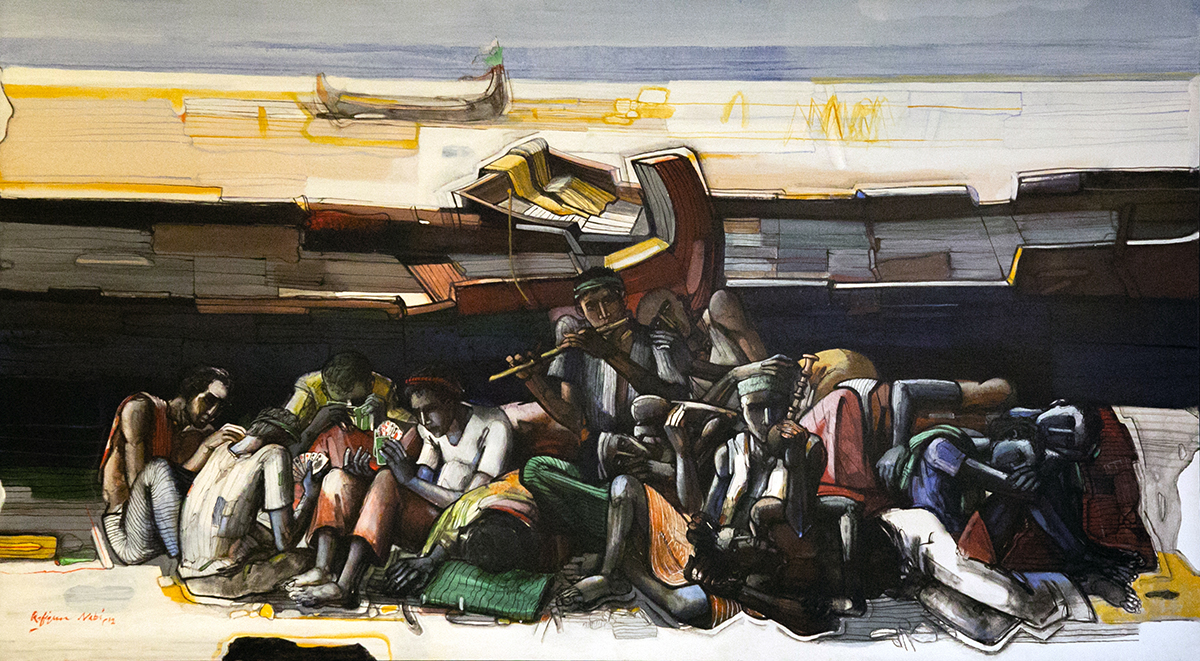
Fisherman at rest, 2012, Rafiqun Nabi
Bangladeshi artist Rafiqun Nabi’s diverse artworks provide a thought-provoking glimpse into social issues and the lives of the working classes in Bangladesh. Here, LUX explores his background and works
Bangladeshi artist Rafiqun Nabi is known for his diverse range of works, from cartoons, paintings, prints, woodcuts, and engravings. Renowned for his ability to blend creativity with social commentary, Nabi’s art sheds light on real issues and the lives of the working classes in Bangladesh.
Born in 1943 in Chapai Nawabganj, Bangladesh, Nabi’s passion for art developed during his school days in Old Dhaka when he began to explore his talent for drawing. Under the guidance of Bengali and Bangladeshi artists, Zainul Abedin and Quamrul Hassan, Nabi’s love for his craft continued to grow and led him to pursue printmaking.

Fisherman at rest, 2012, Rafiqun Nabi
Nabi’s famous cartoon character, Tokai, holds a special place in the hearts of many in Bangladesh and beyond. Tokai, a street urchin with a potbelly and a shaved head, embodies the struggles of poverty and destitution in Bangladesh. Despite his hardships, Tokai exudes cheerful wit, serving as a satirical reflection of the nation’s socio-economic conditions. His character became an emblematic figure for the underprivileged in the country, resonating with people from all walks of life.
Follow LUX on Instagram: luxthemagazine
Nabi’s versatility as an artist is evident in his varied works. He departs from the cartoon style in his painting “Fishermen at Rest” (2012), which portrays hunched figures, entangled in one another as they sleep, play cards, and blow on flutes. The proximity of the fishermen contrasts with the spaciousness of the pier and the distant sea, representing the camaraderie and shared suffering within the fraught fishing industry of Bangladesh. Nabi’s ability to capture the soul of individuals amidst difficult circumstances infuses his art with life and vibrancy, and can also be seen in other works such as “After the Catch” and “Recreation”.

Fisherman, 2016, Rafiqun Nabi
In his painting “Boddho Bhumi” or “Killing Field” (2004), Nabi explores the theme of the liberation of Bangladesh. The piece offers a different perspective, utilising abstraction to evoke the emotions surrounding this significant historical event. In other paintings, such as “Rooster” (2008) he meditates on beauty and nature, focusing on animals which he depicts with a dreamlike quality.
Read more: Rasheed Araeen: The Engineer Behind The Artist
At the core of Rafiqun Nabi’s artistry lies imagination and empathy. His contributions to the art world have been recognised with numerous awards, including the Promoters Prize at Inter Graphic-80 in Berlin (1980), the Bangladesh Shilpakala Academy Award (1989), and the Ekushey Padak (1993).
Find out more: dbfcollection.com/rafiqun-nabi
This article was published in association with the Durjoy Bangladesh Foundation






